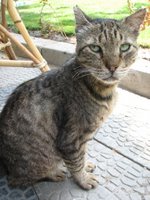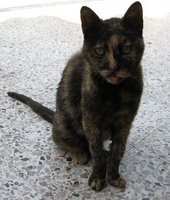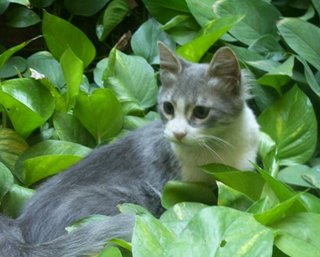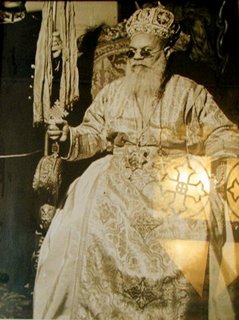Sneak Peak Egypt, Part 1
So what's the use of being a student of Egyptology in Egypt, you might think, if you don't get any geography-related perks? Not much use, really, so of course I went for the perks when they presented themselves. One such perk was one of Dr. Ikram's annual "Middle Egypt Trips," for which the itinerary is never the same, as
 she seems to use these student trips as an excuse to visit sites that even she has never been to before--which are by and large sites which are not (and may never be) open to the general public. This is not to say that in Egypt's baksheesh-based economy that if you are particularly interested in any of these sites you couldn't get there yourself; nonetheless...
she seems to use these student trips as an excuse to visit sites that even she has never been to before--which are by and large sites which are not (and may never be) open to the general public. This is not to say that in Egypt's baksheesh-based economy that if you are particularly interested in any of these sites you couldn't get there yourself; nonetheless...Woohoo! No tourists!
This year the trip was a three-day extravaganza during which Dr. Ikram personally sanctioned nearly the entire Egyptology department skipping a full day of class. We piled into our bus and took off southward, ending up
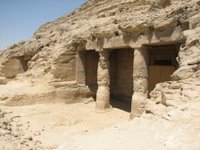 in the quaint city of Minya. We went first to our hotel, where we checked in before a quick tameyya and foul lunch and immediately rushing off to the occasionally-touristed site of beni hasan, the site of a number of Middle Kingdom nobles' tombs, all in rock-cut, courtyard style. The tombs here are known particularly for the richness and unusual content of the paintings they contain.
in the quaint city of Minya. We went first to our hotel, where we checked in before a quick tameyya and foul lunch and immediately rushing off to the occasionally-touristed site of beni hasan, the site of a number of Middle Kingdom nobles' tombs, all in rock-cut, courtyard style. The tombs here are known particularly for the richness and unusual content of the paintings they contain.
Some of this content includes extensive representations of the animals and habitat that existed at the time--extremely useful to archaeologists because they are detailed enough to reveal exactly what species were present. Other unusual content includes scenes of wrestling and "Egyptian Yoga", as well as one of the exceedingly few depictions of sexual intimacy present in ancient Egyptian art, as Lucy enthusiastically pointed out.

Our next site was the also occasionally-touristed Fraser Tombs, a site known for its highly unusual style of "rock-cut mastabas", a type of tomb architecture combining the more popular cave-like rock cut style with the more old school freestanding brick mastaba style. The tombs at this site were considerably less well-preserved as those at Beni Hasan, and frankly quite a lot less interesting, but they did contain some nice examples of mortuary chapel portrait statues and false
doors.

False doors, for those of you not in the know, are (often elaborate) carved representations of doors that are meant to act as a portal of sorts for the ba* of a person to emerge from the tomb and take refreshment from the offerings left before it. A few examples (which I only know from slide lectures and textbooks) even have a carved image of the tomb occupant halfway out of the door, which is actually a pretty creepy and zombified concept, but nonetheless nifty.

The site we visited immediately afterwards is called Tihna el-Gebel. An astoundingly beautiful site, Tihna el-Gebel is centered around a giant freestanding stone outcropping, out of which a small temple of Hathor was carved. There are very exactingly shaped alcoves in the outer sanctuary carved into the walls to house the mummies of two enormous crocodiles done up as offerings for the goddess, and the site is untouched enough that these mummies are today housed along with many other artifacts in a side chamber gated off from the public not only by metal bars, but also by the presence of a huge, open burial shaft which leaves mere inches as the platform to stand on and reach the gated chamber. This explains the photo
 of me as acting Chief Photo Slave of Dr. Ikram--she's got her feet up to keep me from falling backwards into the shaft while I balance and take pictures for her. I actually have good enough balance that I don't think this was necessary, but it does make for a funny picture.
of me as acting Chief Photo Slave of Dr. Ikram--she's got her feet up to keep me from falling backwards into the shaft while I balance and take pictures for her. I actually have good enough balance that I don't think this was necessary, but it does make for a funny picture.Off to the side (and actually, pretty high up on the side of the cliff) of the main temple is also a fertility chapel prominently featuring the god Min, an "ithyphallic" fertility god,
 who is usually portrayed as having only one arm. I use quotes on "ithyphallic" because no authentic depiction of him has ever struck me as particularly tasteless or obscene.
who is usually portrayed as having only one arm. I use quotes on "ithyphallic" because no authentic depiction of him has ever struck me as particularly tasteless or obscene.In any case, the chapel is high up on the cliff, so the rocks leading up to the chapel have been worn completely slick and dangerous by millenia of women climbing up to the chapel to perform a pregnancy rite of sorts: legend has it that if a woman enters the chapel from one side, exits from the other side, then climbs to another ledge where (I believe...I didn't climb to that part) an anointing basin of sorts was carved, she is guaranteed immediate fertility.

The temple is also surrounded by a vast complex of mud brick ruins, which have not been thoroughly studied, so it isn't entirely known what sorts of buildings were there, but it is clear that the site was used as late as the Ptolemaic period, as there is a very clear Greco-Roman influence on some of the art that is there. The site even contains the remains of the largest ancient Greek inscription ever found. There was not enough of it remaining for our two resident Greeks to translate
 anything of substance, but it is an impressive site nonetheless.
anything of substance, but it is an impressive site nonetheless.*A person's ba was only one portion of the "tri-soul" that ancient Egyptians believed each person to have. The most commonly known soul-part is the ka, the essential being of the person in question. Kas are generally portrayed as the image of the person who is dead, but wearing a "hat" in the shape of two upraised arms. The next part, the ba, was a more physical manifestation of the soul, which could interact with the world of the living. Most commonly represented as a bird with the face of the dead person, the ba was thought (even in Amarna times) to be the soul-part which would leave the tomb in search of eternal sustenance for the soul, which would ideally be found in the offerings left to honor the funerary cult of the individual dead. The third part, which may not have
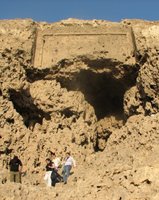 even been a part of Egyptian belief until the New Kingdom, was called the akh. The akh was the portion of the person's soul which would transcend death and the tomb, and reside with the gods in heaven, trailing forever the solar barque on its journey through the sky and underworld. In the New Kingdom, commoners often practiced a form of ancestor worship in which they would create household shrines dedicated to the akh iker ("wise soul"), the collective spirits of their household dead. The theory behind this was that if Grandma was up in heaven hanging out with the gods every day, then maybe if you prayed to her instead of the gods themselves, who were obviously too busy to hear everyone's prayers, then maybe Grandma would be able to put in a little good word for you and get your prayers answered faster.
even been a part of Egyptian belief until the New Kingdom, was called the akh. The akh was the portion of the person's soul which would transcend death and the tomb, and reside with the gods in heaven, trailing forever the solar barque on its journey through the sky and underworld. In the New Kingdom, commoners often practiced a form of ancestor worship in which they would create household shrines dedicated to the akh iker ("wise soul"), the collective spirits of their household dead. The theory behind this was that if Grandma was up in heaven hanging out with the gods every day, then maybe if you prayed to her instead of the gods themselves, who were obviously too busy to hear everyone's prayers, then maybe Grandma would be able to put in a little good word for you and get your prayers answered faster.To be continued...


